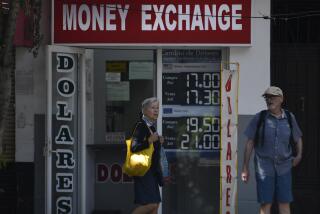In Europe, Views, Impact of Dollar Vary
LONDON — Across Western Europe, manufacturers are bemoaning the rising value of European currencies, saying it makes their exports less competitive. Consumers, on the other hand, are happily opening their wallets for U.S.-made products and Florida vacations, which look cheap on this side of the Atlantic when calculated in pounds and euros.
Look through the business pages of European newspapers these days, and a headline or two is likely to show reduced corporate earnings because of softness in sales to the huge U.S. market.
But the effect varies widely depending on industry and region, with more of the pain felt by tourist destinations favored by Americans and some industrial products sold in the United States. Many luxury goods exporters seem to be absorbing the impact of a weaker dollar well.
The greenback’s decline could knock half a percentage point off of European growth over the next few years but should not be cause for great alarm, said Gavin Cameron, an economics professor at Oxford University.
Although European officials are complaining, he said, many academics see the currency slide as a timely adjustment that could help the U.S. economy avert a recession that would cause more pain in Europe later.
A commentator for the Times of London, Anatole Kaletsky, is more worried. He warns that Europe faces a “devastating pincer movement” with high-end, high-technology exports fighting an uphill battle against a falling dollar, and low-end, labor-intensive goods undercut by cheap production in Asia.
The dollar’s value has fallen about 10% against the euro since September and 5% against the British pound. It now takes nearly $2 to buy a pound and more than $1.35 to buy a euro.
Elizabeth Amelio, an American living in Rome, said expatriates were suffering from the plunge. Her husband, a portfolio manager for an investment bank, is paid in dollars, and “it makes it difficult to live here,” she said.
“Products were already more expensive here compared to the U.S. By now, it’s almost twice the price. I have to watch my expenses, and I think twice before buying,” Amelio said.
“I used to think one dollar, one euro. Now, I force myself to multiply, because when I get my credit card bills, I realize that it’s almost double.”
More than 6,000 winemakers demonstrated in France’s Bordeaux region this month to draw government attention to their plight.
The industry suffered declining sales this holiday season as the falling dollar and a government-sponsored campaign against drinking and driving took their tolls.
The French spirits group Remy Cointreau also has felt the pinch. The family-owned business records more than half of its sales in exports outside the euro zone, much of it to the United States.
“Over the past three years, the falling dollar alone represented a 95-million-euro impact,” Herve Dumesny, financial manager of the group, told the French business newspaper Les Echos.
In a recent interview with the Portuguese paper Publico, French Prime Minister Jean-Pierre Raffarin said the euro zone countries should be very “vigilant” toward the falling dollar. “A strong euro reduces the energy bill, which is calculated in dollars, but it weighs on our exports and on Eurozone’s economic growth,” he said.
Bernabo Bocca, president of Federalberghi, the Italian hotel association, called the weak dollar “a tragedy for tourist operators.” Bocca said 12% more Americans traveled this year than last, but they chose dollar destinations such as the Caribbean.
“If Americans do travel to Italy, they spend less money than they used to,” he added. “Now that the $1.31 barrier has been passed, you don’t know where it will go.”
Yet Anton Boerner, president of the Federation of German Wholesale and Foreign Trade, which represents 120,000 export and trading companies, sees no reason for hysteria. “We still assume a growth of our exports by 5% to 7% in 2005, after nearly 10% in 2004,” he told Der Tagesspiegel recently.
“More than half of our exports go to the euro region -- goods worth more than 440 billion euros,” the trade executive added. “Exchange rates do not matter here. And [the same is true of ] our competitors in Belgium, Spain and France.”
The German state bank noted that 75% of German exports were invoiced in euros and only 16% in dollars. The current rise in mechanical engineering and automotive exports has so far offset the currency effect, it said.
In October, German automobile makers said their exports had increased slightly from the year before. They have had a setback in the U.S., however, having had to offer high discounts. In 2004, Volkswagen will lose about 1 billion euros on its U.S. operations.
To secure their business with the dollar region, nearly all major German companies employ currency trading strategies to compensate for the fluctuations.
Christian von Guradze, co-owner of the 200,000-acre wine estate Dr. Buerklin-Wolf at Wachenheim, in the Pfalz region, said he was the biggest German wine exporter to the U.S. in his price range ($20 to $50 for a bottle of Riesling). But his wine has become 50% more expensive there in the last two years.
Yet “we did not have any losses in our export sales to the United States because of the plunging dollar,” Von Guradze said. “I am not worried. I did the right dollar hedging two years ago, and I will continue to secure my sales that way.”
Tobias Wendt, co-owner and manager of Wendt & Kuehn, a traditional manufacturer of handcrafted folk-art figures, said his company had assumed the currency risk for the U.S. consumer.
Before World War II, the family business located in eastern Germany’s Erzgebirge Mountains sold nearly half of its output in the United States most years, Wendt said, but that has shrunk to 10%.
“We sell our products for dollars, and that means the currency risk is fully shouldered by us. What makes things worse is that the American customer thinks, ‘Oh, this comes from Europe, it has to be expensive.’ And this happens even though our prices in the U.S. have been stable for many years.”
According to the Italian foreign trade institute, exports to the U.S. have not been significantly affected. Those that have declined were mostly industrial goods such as chemicals, paper and wood.
Food companies exporting products such as Parma ham and Parmigiano cheese, meanwhile, have not seen a drop in exports, nor has high-fashion clothing exporters such as Armani and Valentino.
The United States accounts for the majority of sales at Smith & Nephew, a British company that makes medical devices such as replacement hips and endoscopic instruments.
Even though the company hedges to reduce its currency risk and does business worldwide in many currencies, it has felt the impact recently. However, an executive said she expected no long-term impact on earnings.
“Currency makes a difference, yes,” said Liz Hewitt, corporate affairs director. “But our fundamental growth drivers are around demographics and the baby boomers using our products, so it is not going to make a fundamental difference.”
Achrene Sicakyuz in The Times’ Paris Bureau, Petra Falkenberg in the Berlin Bureau, Janet Stobart in the London Bureau and Maria De Cristofaro in the Rome Bureau contributed to this report.
More to Read
Inside the business of entertainment
The Wide Shot brings you news, analysis and insights on everything from streaming wars to production — and what it all means for the future.
You may occasionally receive promotional content from the Los Angeles Times.










